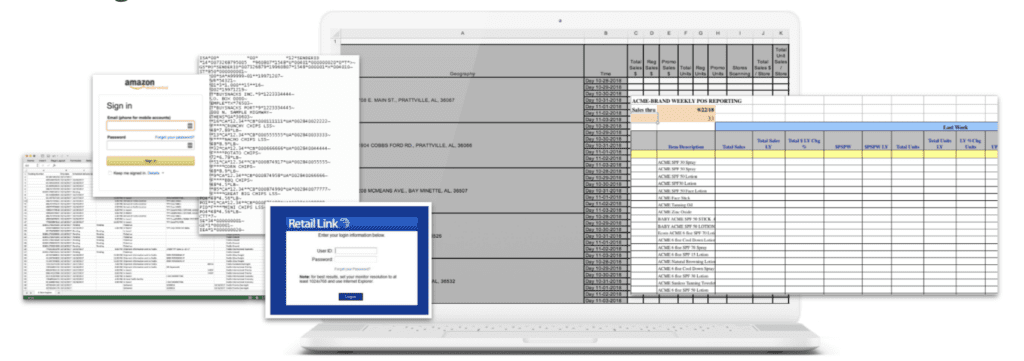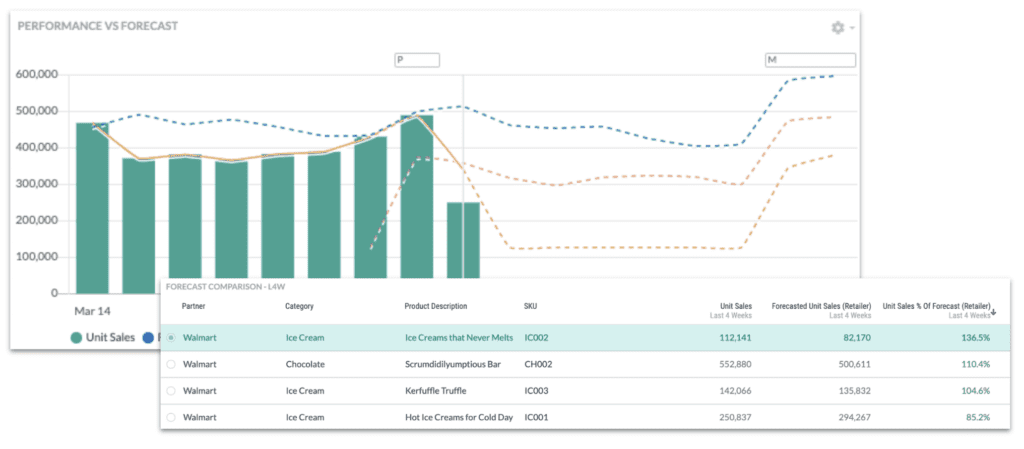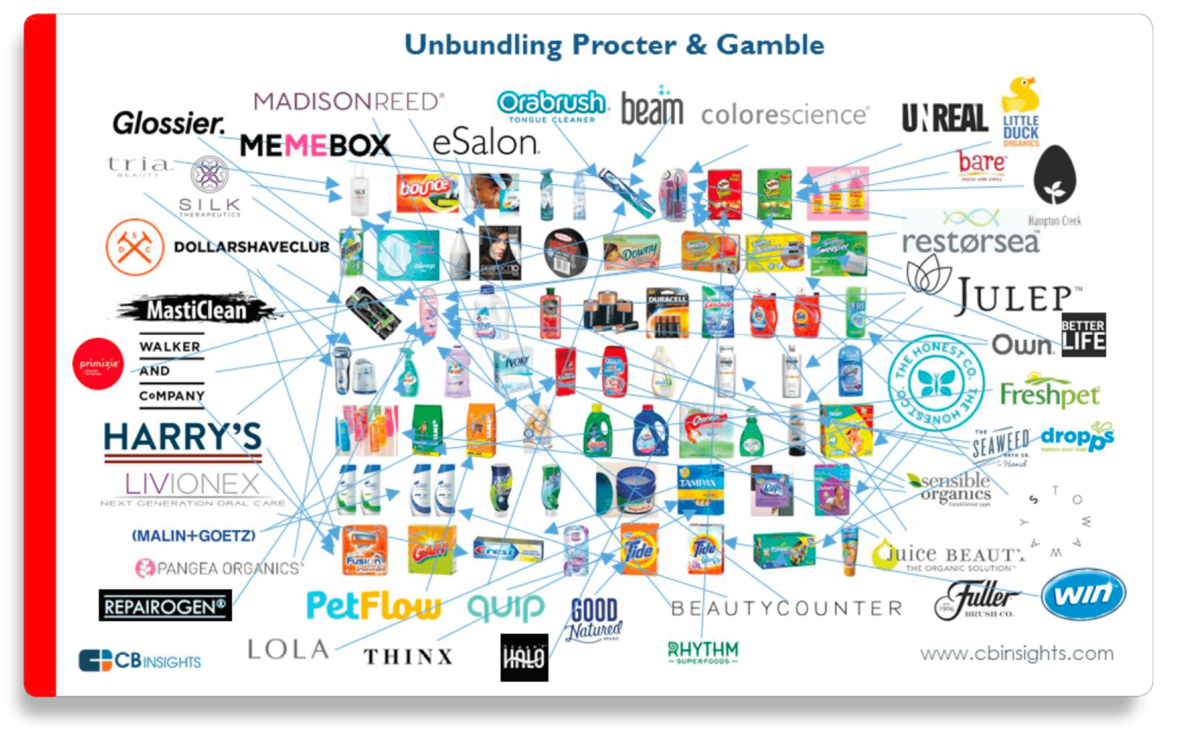- Franklin Morris
Table of Contents
The Omnichannel Dilemma: Digital-First Brands Must be Where Customer Are - in Retail
Many of the hottest, most successful, and disruptive consumer brands of the last decade started as direct-to-consumer (DTC) or digital-native companies. Being a digital native came with distinct advantages in the retail era, namely allowing these upstarts to better tap into consumer demand through the insights gleaned from digital channels and to engage in more precisely targeted marketing via online paid ads. This direct line to the consumer gave them an immediate advantage in categories crowded with traditional retail-only competitors, fueling their growth. Going against traditional, established brands means it’s an all-out battle for market share; moving into retail is a way to take that battle directly to the establishment.
But DTC and digital-first brands quickly realized that selling through direct or ecommerce channels alone was impeding growth. As these companies grew, they found that the cost of acquiring new customers online through paid advertising was simply too high and too limiting. In the words of Imran Patel, Quip’s VP of Business Development and Partnerships:
“The direct to consumer channel is incredibly valuable to us. It has impacts across our business, but we know that not everybody is engaging in buying their oral care products that way. Customer acquisition costs are, or CAC, is top of mind for anybody who’s operating in e-commerce […] We see those customer acquisition costs rise over time. And so, as we think about where to find more customers, how do we do that in an efficient way? We can’t always just continue to spend and spend and spend on customer acquisition through digital channels. Then traditional retail becomes, for many, something to start thinking about.”
But successfully launching in retail as a digital-first brand can be a minefield:
- When it comes to getting your products to the shelf, retailers don’t leave it up to chance. Many digital-first brands are surprised to find out that the ownership of making data-driven allocation decisions really falls to them. Retailers are simply not going to ensure that your products get to the stores they need to get to.
- Data challenges abound. There is a lot of data available in retail, but extracting insight from the data is very manual and extremely difficult to manage without large teams of analysts who have deep retail expertise.
- Marketing is just as important, but different. Measuring the ROI of marketing spend on paid channels like Facebook, Instagram, and Google is relatively straightforward. In the physical world? Not so much.
Put another way: The data-savvy strategies that got these brands here won’t necessarily get them there. Many digital-first brands find this out the hard way when their products underperform on the shelf or they walk out of a bad line review with a retail partner, and go looking for answers.
“Going against traditional, established brands means it’s an all-out battle for market share; moving into retail is a way to take that battle directly to the establishment.”
The good news is, it is possible to understand these challenges and to take a data-driven approach to solving them before they become problems for their brand. Alloy has been helping digital disruptors like Quip, Native, Bliss, Tile, and Youth to the People launch successfully into retail for years, and we’ve compiled that knowledge and best practices into this guide.
Three Pitfalls Digital Brands Encounter in the Retail World
#1 – Relying on your retail partners to make the right inventory allocation and marketing decisions.
CPGs are surprised to find out that retailers expect them to own analytics during launches. If you’re launching a new product, the retailer is not going to be watching to make sure that it gets to all these stores it’s supposed to get to.
For example, if you’re new to retail, you’re probably not going to launch fully distributed. If you’re new to retail and launching three new SKUs in 500 doors, you need to be hyper-focused on making sure your product is getting where it is supposed to be. That’s 100% of your retail business, but to the retailer, it’s not a top priority. They are not going to be watching or looking at any kind of granularity in the reporting. They’ll simply look at the first eight weeks of sales when they go into a line review and ask themselves, “Did this go well or go badly?”
Moreover, in many cases, retailers may not be distributing inventory effectively on your behalf. Retailers may be doing things like distributing products equally to different locations, so you may end up with just as many products shipped to a Walmart in North Dakota as a Walmart in Silicon Valley, despite having much more consumer demand in the California location.
In reality, brands should be telling their retailers where to allocate their inventory to mitigate out-of-stocks, lost sales, and phantom inventory problems. It’s on you, the brand, to provide a level of feedback on where things are going wrong. We often see it take six months to a year for brands that are new to retail to figure this out.
#2 – Plenty of data, not enough insights.
If you’re just starting a push into retail, you may not have felt the pain of retail data portals yet, but if you’ve been selling into retail for even a short time, you certainly have. DTC brands that are dependent on comparatively easy-to-use ecommerce systems (such as Amazon or Shopify’s back end) that put analytics at their users’ fingertips should prepare to be shocked.
The tragic state of retail data.
Brands will quickly encounter a few significant data challenges. The first is the ability to consistently get the data they need in a way that doesn’t consume all of their time. “Now with a dozen partners who deliver data in a dozen different ways, without having a unified view of that data, we’d spend all of our time just trying to figure out what’s on the scoreboard,” says Quip’s Imran Patel.
“Now with a dozen partners who deliver data in a dozen different ways, without having a unified view of that data, we’d spend all of our time just trying to figure out what’s on the scoreboard.”
– Imran Patel, VP of Business Development and Partnerships @ quip
This is because of the unintuitive, difficult-to-use UIs of these retailer data portals. One sales analyst at a leading consumer electronics company told us that the UIs on these portals are so terrible that you end up spending the first several hours of every day just trying to pull down the data you need and get it into a spreadsheet. You need to know exactly what you’re looking for, what filters you’re applying, and what reports you want to run.
And that is just the work of getting the data. Another major challenge arises when you start trying to format the data. It isn’t really in a form that lends itself to the granular, store-level insights brands need to make decisions. With Target and Walmart, you do have access to granular store item-level data, but these are just called out as columns in a spreadsheet (a column for a store identifier, a column for a product identifier, several metrics around sales, and so on). It is very difficult to then add in any supplemental information, such as where the store is located, and what DCs are servicing these stores. Even with a BI tool such as Power BI or a Tableau, brands find it difficult to be able to really drill down in a way where the data is structured effectively.
Digital-first and DTC brands are not going to get the most out of this kind of data with any of the tools or methods that they’ve been using in the DTC world. When you go from talking about tracking shipments from one or two warehouses to suddenly selling through hundreds or even thousands of retail stores, things get very messy very fast.
#3 – Marketing in retail is not what you’ve come to expect.
If you can’t measure marketing performance, you can’t double down on what works and cut underperforming investments. You also won’t forecast promotions accurately.
Marketing is a competitive advantage and core competency for most direct-to-consumer brands. Retaining this advantage to acquire customers in retail ultimately uses similar methods, but is undertaken on a completely different scale and timeline. How do you drive people to stores? How do you get the same kind of data and insights you used successfully in their online channels to drive growth in their retail channels?
Quip’s Imran Patel on marketing in direct vs. retail channels.
Five Best Practices for Success in Retail Channels
#1 – Protect your market share by staying on the shelf.
For any brand selling into retail, reducing out-of-stocks should be top of mind. For brands that can’t keep their products on the shelf when and where consumers want them, the numbers paint a grim picture:
- 74% of consumers switched brands in 2020 as a result of a lack of product availability. (Marketing IQ)
- 65% of consumers have switched brands “often” or “very often” during the summer of 2021 (Food Dive)
- Among shoppers who made a switch, only 36% said they would return to the original brand. (Food Dive)
The message from consumers is clear: If you’re not on the shelf, your brand is at risk of not just losing one sale, but a lifetime of sales. Our seven-step process for identifying out-of-stocks and quantifying lost sales is a quick roadmap for how to begin mitigating these problems, including advice on how to:
- Identify specific, chronic instances of OOSs
- Quantify these losses with a simple formula
- Diagnose the root causes
- Frame your recommendations for your retail buyers to prevent future issues
Read the full guide here. And see a walkthrough of how customers identify and resolve out-of-stocks in Alloy:
#2 – Identify and resolve phantom inventory issues.
Phantom inventory is the silent killer that’s sapping billions of dollars in revenue from consumer goods brands and retailers. Phantom inventory occurs because items that don’t exist in reality still appear in the digital ledgers of stores and DCs in your retail network, blocking replenishment and masking the problem. It can occur because of theft, unreported shrinkage, and other random loss of inventory.
Watch this brief demo video to learn how to:
- Understand sales and inventory patterns over time at a store-item granularity to triangulate red flags.
- Pull recent and granular data and run daily logic analysis across all store items to flag instances where sales are expected, but not occurring — even when it appears retailers have sufficient inventory.
- Use alerts to trigger replenishment and restart sales.
Additional resources on phantom inventory:
#3 – Take a “test and learn” approach to your retail marketing, just like you would in digital.
Marketing is just as important in the retail world as it is in the digital world, but the rules of the game are different. Brands spend millions of dollars on marketing each year, but they often struggle to understand the ROI of which promotions are working in retail.
Personal care and deodorant brand Native (acquired by Procter & Gamble) found this out when they began their push into retail. “You don’t have access to a lot of the consumer data,” Meng Li, Native’s VP of Marketing, tells CGT. “Retailers don’t share as much, and the data that you can pull is really hard to manipulate.
“Rather than doing kind of a general, national campaign for marketing, we’re really able to use Alloy data to divert and reallocate spend to really focus on the areas where we don’t have as much sales,” Li says, including isolating the regions where brand awareness is needed.
Brands selling into retail quickly learn that you can’t improve what you can’t measure. The truth is, it is possible to measure every single marketing activity in real-time, so you can continually cut bad investments and double down on what’s working.
- Use real-time POS data to understand sales lift during an event so you can quickly adjust as needed.
- Shift from measuring only some of your marketing activities to all of them with a platform that makes it easy to stand up new experiments in minutes.
- Do more of what works by identifying and replicating your successes.
- Cut bad investments. Identify underperforming promotions and price discounts and test new strategies before making bigger bets.
See how you can easily run a real-world A/B test with a few clicks in Alloy:
Alloy Experiments: retail marketing and promotions measurement.
#4 – Master a data-driven approach to new product introductions, to ensure success in retail channels.
Managing the data you’re pulling out of your retail portals happens in a few stages:
- Access the data across your direct, e-commerce, and retailer channels.
- Refine the data. Design a repeatable process to take you from the thousands of different metrics that exist down to the five that you need.
- Translate the data, because at Target, you’ll be dealing with DPCI format, compared to a UPC format at another retailer.
- Determine which KPIs are valuable to each retailer, because this will differ for retailers.
Today’s spreadsheets and BI tools are simply not equipped to handle this kind of complexity. What brands need is a data platform that is purpose-built for consumer goods brands selling into multiple online and offline channels.
With the right platform, brands can easily identify, prioritize, and resolve execution issues during important events like product introductions, letting them:
- Review how inventory is building within the channel and the product adoption curve
- Drill into stores that have received no inventory and stores not selling any items, indicating store execution problems
- Identify stores sold through with no current inbound inventory, which should be immediately replenished
- Bring specific location-level issues and a recommended set of solutions to your retailers
See our overview of new product introductions in Alloy to see how consumer goods brands are accomplishing this in our platform.
#5 – Reconcile your retail forecast with your partner’s supply plans.
Even if you’re a category leader, your buyer is likely relying on a machine learning-generated supply plan and can be managing upwards of 50+ other suppliers just like you. As mentioned earlier in this guide, the onus is on you to ensure your retail forecasts are matching up to their supply plans.
Our quick guide to retail forecast monitoring will detail how you can reconcile your forecast and your retailer’s supply plan in a few different situations:
- For seasonal and event-based demand patterns – Whether you’re preparing for the holiday season, a big promotion, or a weather-driven period of increased demand, you should engage and advise your retail partners on their supply plans for your products.
- For consistently replenished items – For fast-moving products with (relatively!) stable demand, maintaining alignment between your forecasts and your retailers’ supply plans is an ongoing battle.
Retail forecast monitoring in Alloy.
Conclusion: The Risk & The Opportunity Ahead
Pushing into new stores and new doors can be intimidating at first, but it’s actually a huge opportunity for direct-to-consumer and other digitally savvy brands that think like disruptors. This is evidenced by the fact that “big brands are being nibbled to death,” according to IAB:
Consumer brands that push into retail with the same data-driven rigor and thoughtfulness will continue to come out ahead in the battle for market share, even against much more established competitors.
About Alloy.ai
Alloy equips consumer goods brands to adapt quickly to changing commerce by aligning execution and planning to real-time consumer demand. Our cloud platform connects real-time POS data to supply chain visibility, providing a single pane of glass that breaks down silos within and across supply chain, planning, sales, and marketing teams. Team members can proactively address risks and maximize opportunities as they monitor demand trends, evaluate performance against forecasts, and drive collaboration internally and with partners to adjust execution and plans.
Companies ranging from the Fortune 500 to digital-natives use Alloy every day to grow customer relationships, improve service levels, and prevent out-of-stocks while lowering costs.

Franklin Morris
Franklin Morris is Vice President and Head of Global Marketing at Alloy.ai. He's spent his career leading brand, content and demand generation marketing for high-growth startups, ad agencies, and Fortune 50 giants, including IBM, Dell, Oracle, Rackspace, 3M, Facebook, Electronic Arts, Informatica, Sisense, and Argo Group.




